Ebermannstadt
| Ebermannstadt | ||
|---|---|---|
| ||
 Ebermannstadt | ||
Location of Ebermannstadt within Forchheim district 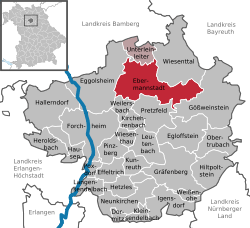 | ||
| Coordinates: 49°46′N 11°10′E / 49.767°N 11.167°ECoordinates: 49°46′N 11°10′E / 49.767°N 11.167°E | ||
| Country | Germany | |
| State | Bavaria | |
| Admin. region | Oberfranken | |
| District | Forchheim | |
| Municipal assoc. | Ebermannstadt | |
| Government | ||
| • Mayor | Franz Josef Kraus (CSU) | |
| Area | ||
| • Total | 49.97 km2 (19.29 sq mi) | |
| Population (2015-12-31)[1] | ||
| • Total | 6,904 | |
| • Density | 140/km2 (360/sq mi) | |
| Time zone | CET/CEST (UTC+1/+2) | |
| Postal codes | 91316–91320 | |
| Dialling codes | 09194 | |
| Vehicle registration | FO (old: EBS) | |
| Website | www.ebermannstadt.de | |
Ebermannstadt is a town in the district of Forchheim, in Bavaria, Germany. It is situated 10 km northeast of Forchheim and 25 km southeast of Bamberg.
Districts
- Breitenbach
- Ebermannstadt
- Gasseldorf
- Niedermirsberg
- Rüssenbach
- Neuses-Poxstall
- Wohlmuthshüll
- Buckenreuth
- Moggast
- Wolkenstein
- Thosmühle
- Burggaillenreuth
- Windischgaillenreuth
- Eschlipp
- Kanndorf
History
The place on which Ebermannstadt is located today was already named imperial "villa Ebermarstad" in 981. At one point later it became the possession of the Schlüsselberger family. In 1430, the Hussites destroyed the place. Again, Ebermannstadt faced destructions during the Second Margrave War in 1552, the Thirty Years' War and finally in 1796 when the French army passed through the town. Albrecht Dürer stayed in Ebermannstadt in 1515 and painted an oil-painting of the town.
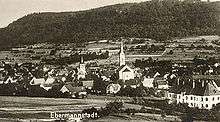
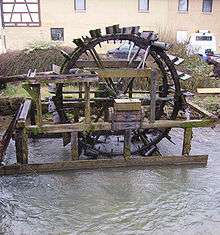
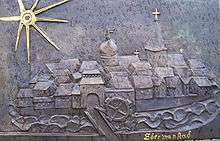
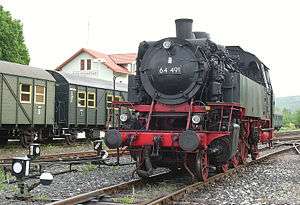
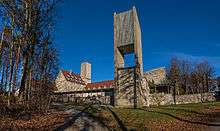
Chronology
- 531 Thuringian foundation, Location of an "Ebermar"
- 981 First documented record of "Ebermarestad"; Ebermannstadt was part of St. Peter Monastery in Aschaffenburg
- 1194 Record of Thimo and Cunradus de Ebermarstatt
- 1200 The new owner of Ebermannstadt were the Schlüsselberg
- 1308 Record of a church in Ebermannstadt
- 1323 Ebermannstadt became market town during the reign of Louis IV
- 1349 Partitioning of the Schlüsselberg possessions
- 1390 Ebermannstadt is transferred to the Hochstift Bamberg
- 1430 Hussites burn down Ebermannstadt
- 1469 Ebermannstadt becomes an independent parish
- 1510 Beer war with Pretzfeld for the right to brew
- 1552 / 1553 Margrave Albrecht Alcibiades von Brandenburg-Kulmbach army destroys the town during the Second Margrave War
- 1633 The Swedish army occupies the town during the Thirty Years' War
- 1748 Birth of Friedrich Theiler
- around 1750: Principal Frantz Melchior Freytag writes the "Ebermannstädter Liederhandschrift"
- 1756-1763 Quartering of Prussian soldiers during the Seven Years' War
- 1772 Birth of Johann Georg Lahner in Gasseldorf
- 1796 - 1815 Occupation by the French army during the French Revolutionary Wars
- 1803 Secularization, Ebermannstadt becomes part of Bavaria
- 1862 Foundation of the county of Ebermannstadt
- 1891 Inauguration of the railroad line between Forchheim and Ebermannstadt
- 1903 Electricity power station
- 1907 District hospital
- 1909 Flood
- 1915 Opening of the railroad line to Heiligenstadt
- 1922 Opening of the railroad line Gasseldorf - Muggendorf (later extended to Behringersmühle)
- 1922 - 1923 Construction of the water conduit
- 1939 Annexation of Breitenbach
- 1941 Feuerstein Castle was used as laboratory for high frequency engineering
- 1945 Local elections in Wohlmuthshüll
- 1952 Airport for gliders
- 1954 Construction of a Realschule
- 1960 Suspension of passenger traffic on the train line to Heiligenstadt
- 1961 Protestant Emmaus Church
- 1965 Outdoor swimming-pool
- 1970 Twin-city Chantonnay; flood
- 1970 - 1974 Construction of the Gymnasium Fränkische Schweiz (high school)
- 1971 Annexation of Gasseldorf and Niedermirsberg, Rüssenbach and Neuses-Poxstall
- 1972 Dissolution of the county of Ebermannstadt, Annexation of Wohlmuthshüll and Buckenreuth
- 1976 Suspension of train traffic between Ebermannstadt and Behringersmühle
- 1978 Annexation of Eschlipp and Kanndorf, Formation of the administrative collectivity Ebermannstadt
- 1979 Landslide near Eschlipp
- 1981 Ceremony "One Thousand Years of Ebermannstadt"; Inception of scheduled train traffic of the steam railroad as a tourist attraction
- 1994 Elevation to "Possible Middle Center"
- 1999 Observatory Feuerstein
Tourism
Ebermannstadt is a state-approved resort town with an open-air swimming pool, campground in the district of Rothenbühl, golf course in the district of Kanndorf and a sport airfield on top of the Feuerstein.
During clear nights, there are guided tours at the Observatory Feuerstein. Thanks to the excellent conditions, it is possible to get a very good view of the universe.
Sights
Buildings
The most important sacred buildings of the town are the Maria Chapel and the neoroman Nicholas Church. Old Franconian timbered buildings are located near the market place with Maria Well. Landmark of the town is the scoop wheel from 1606 on the Wiesent. Feuerstein Castle, which was built only in 1941 in the style of Franconian castles, stands out above the town.
Economy
The largest companies in Ebermannstadt are
- Kennametal
- Vierling
Personalities
- Kurt Albert (1954-2010) teacher, climber, photographer
References
- ↑ "Fortschreibung des Bevölkerungsstandes". Bayerisches Landesamt für Statistik und Datenverarbeitung (in German). June 2016.
